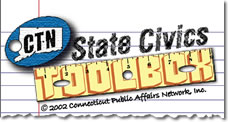|
|
CT-N Legislative Session “The Great Discussion” |
- Video Session: HB 5274 An Act Requiring A Civics Course for High School Graduation. House of Representatives, Regular Session April 11, 2000
Content: This large group discussion provides the opportunity for students to examine opposing viewpoints, analyze material, and develop solutions to the complicated issue of mandatory civics education.
Class Time: One to two class periods
Objectives: Students will evaluate the legitimacy of a civics requirement, considering both today's educational system and its historic context. Students will demonstrate understanding of proper business letter format by writing to their State representatives.
Activity:
- Day 1: Have each student write a brief response to the prompt: What is the purpose of schooling in the United States of America?
- Show selected clip(s) from CT-N video of legislative debate. After watching selected clip, distribute question sheet and copy of bill to each student.
- Divide class into groups of three (may be larger depending on class size); give groups ten minutes to review what they saw in the video clip and compare it to the questions on the sheet. Students should be encouraged to share initial reactions with each other, and to formulate early responses for discussion.
- Move into large group discussion with teacher as moderator. Keep discussion moving while allowing students to share response and ideas freely.
- Day 2: Continue large group discussion. Attempt to reach some sort of consensus regarding the overarching question posed: Did the CT legislature act in an appropriate manner when mandating civics as a requirement for graduation?
- Final Cumulative Activity - Letter to Representative/ Senator:
- With conclusion of discussion, assign each student to write a letter, using proper business format, to his/her Representative or Senator expressing his/her view on the Act; letters should outline the students' reasoning and suggest ways of meeting the challenge of civic participation.
- Notes to Teacher:
- The length of video clip shown and what sections used should be determined by the class makeup.
- Based on time and the level of your class, a list of key speakers, quotes or points raised within the videotaped session may be helpful to generate discussion.
- For general discussion question number six, students could be asked to develop a survey, administer and analyze it either prior to or as a follow-up to the class discussion.
- The questions that should be answered prior to any discussion or learning about civics is, "What is civics and what does it mean to you?" This question is deceptively simple, but it lies at the heart of the effectiveness of a civics education. Before jumping into the issue, students need to think about the role government has played in their lives from birth to present. They should brainstorm, write personal reflections, and share those reflections with the class. A "class list" could be generated to detail all of the points raised by the individuals in the class to allow for expanding each student's initial reaction. Once these important overarching questions are answered, students' discussions about civics and the role of school sin teaching civics will be necessarily more meaningful.
- Enduring Understandings:
- Civic participation is both highly individual and essentially collective.
- The American democratic republic is predicated on the active, educated
participation of its citizenry at all levels.
- Essential Questions:
- What is civics and what does it mean to you?
- How should concern over civic knowledge and participation be addressed?
If you have any comments or suggestions about this activity or would like to submit your own activity, please
contact us and share your ideas.
